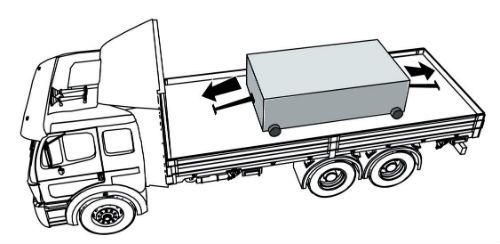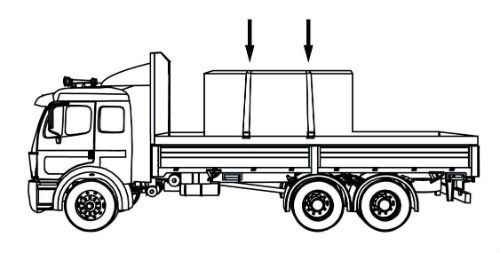CDL Practice Tests: Flatbed Cargo Securement
Choose A Section:
Go!The Aggregate Working Load Limit should, at minimum, be:
- 50% of the weight of the cargo.
- 100% of the weight of the cargo.
- 80% of the weight of the cargo.
- Determined by the shipper.
How much should the Aggregate Working Load Limit be?
The aggregate working load limit of any securement system must be at least 50% of the weight of the cargo being secured.
Securing heavy vehicles or equipment with crawler tracks or wheel requires a minimum of how many tiedowns?
- 6
- 4
- 2
- It depends on the weight of the load
Special Circumstances: Securing Heavy Vehicles, Equipment, or Machinery with Crawler Tracks or Wheels
Tiedown requirements
- Restrain cargo using a minimum of four tiedowns, each having a WLL of at least 2,268 kg (5,000 lb.).
- Prevents cargo movement in the side-to-side, forward, rearward, and vertical directions.
-
Attach tiedowns:
- Either at the front and rear of the vehicle.
- Or at the mounting points on the vehicle designed for that purpose.
When securing building materials, how many knots are acceptable in the tiedown(s)?
- 0
- 1
- 2
- Depends on the weight of the cargo.
Requirements for Securement System:
- In proper working order with no damaged or weakened components that affect their performance or reduce their working load limit.
- No knots.
- Attached and secured in a manner that prevents them from coming loose during transit.
- Able to be tightened by a driver of an in-transit vehicle.
- Located inboard of rub rails whenever practicable.
- Edge protection must be used when a tiedown would be subject to abrasion or cutting.
A female housing fixed to the side or ends of a vehicle to receive a stake or peg, and may also be used as an anchor point is a:
- Cleat
- Bulkhead
- Stake pocket
- Void filler
Stake Pocket:
A female housing fixed to the side or ends of a vehicle to receive a stake or peg, and may also be used as an anchor point.
A container chassis vehicle is defined as:
- A specialized container, primarily used to contain and transport materials in the waste, recycling, construction/demolition, and scrap industries, which are used in conjunction with specialized vehicles, in which the container isloaded and unloaded onto a tilt frame body by an articulating hook-arm.
- A structure, device, or another substantial article placed against an article to prevent it from tipping that may also prevent it from shifting.
- A vehicle especially built and fitted with locking devices for the transport of intermodal containers.
- A reusable, transportable enclosure that is especially designed with integral locking devices that secure it to a container chassis trailer to facilitate the efficient and bulk shipping and transfer of goods by, or between various modes of transport, such as highway, rail, sea, and air.
Container Chassis Vehicle:
A vehicle especially built and fitted with locking devices for the transport of intermodal containers.
Cargo securement for a load weighing 37,000 lbs must be able to withstand a minimum forward braking force of:
- 7,400 lbs
- 10,000 lbs
- 18,500 lbs
- 29,600 lbs
How well must the securement system work? (Section 1.3)
Each cargo securement system must be able to withstand a minimum amount of force in each direction.
- Forward Force = 80% of cargo weight when braking while driving straight ahead.
- Rearward Force = 50% of cargo weight when accelerating, shifting gears while climbing a hill, or braking in reverse.
- Sideways Force = 50% of cargo weight when turning, changing lanes, or braking while turning.
-
Upward Force = 20% of cargo weight when traveling over bumps in the road or cresting a hill.
- This requirement is satisfied when the cargo is "Fully Contained."
What is a headboard?
- A vertical barrier placed directly behind the cab of a tractor to protect the cab in the event cargo should shift forward.
- A transverse load bearing structural component, particularly a part of a log bunk.
- A vertical barrier across the front of the deck of a vehicle to prevent forward movement of cargo.
- A vertical barrier across a vehicle to prevent forward movement of cargo.
Headboard:
A vertical barrier across the front of the deck of a vehicle to prevent forward movement of cargo.
When securing concrete pipe with a diameter up to 45 inches loaded crosswise as a group, a crosswise tiedown should be used every how many feet?
- 15
- 6
- 10
- 3
As a group
Place lengthwise tiedowns over the group of pipes:
Either one 13 mm (1/2 in) chain or wire rope,
Or two 10 mm (3/8 in) diameter chain or wire rope
Place one crosswise tiedown for every 3.0 m (10 ft) of load length.

Either attach the side-to-side tiedown through a pipe
Or pass the tiedown over both front-to-back tiedowns between two pipes on the top tier.
What is the minimum Working Load Limit for the entire securement system?
- 100% of cargo weight.
- 20% of cargo weight.
- 80% of cargo weight.
- 50% of cargo weight.
Note: The minimum WLL requirement for the securement system is 50%. More tiedown capacity should be used if you need to secure an article against any movement.
How many anchor points should be used to secure an intermodal container on a chassis vehicle?
- 2 latches in the front and 2 in the middle.
- 4 latches total, anywhere on the trailer.
- 2 latches each at or near both the front and rear.
- 2 latches in the middle, and 2 at the rear.
Secure the front and rear of the container independently.
- 2 latches on the chassis engage anchor points towards or at the front of the container.
- 2 latches on the chassis engage anchor points towards or at the rear of the container.
About The Flatbed Cargo Securement CDL Manual
Studying the flatbed cargo securement CDL manual is not a requirement for getting your CDL permit or license. It is required knowledge for flatbed drivers.
Some questions you should be able to answer for flatbed cargo securement:
- What is the minimum Working Load Limit of a tiedown used to secure logs?
- What is the minimum weight of a shipment of paper rolls that would require specific securement requirements?
- When securing concrete pipe over 45 inches loaded crosswise, which direction must the tiedowns on the front half of the load run?
- What is a cab shield?
- When securing concrete pipe over 45 inches loaded crosswise, which direction must the tiedowns on the rear half of the load run?
- What is a dunnage bag?
- Who is responsible for inspecting securing devices and cargo within the first 50 miles?
- How many tiedowns are required on a stack of shortwood loaded crosswise?
- What is the minimum working load limit of each tiedown used to secure crushed or flattened vehicles?
- Define 'bolster'
- What is a hook-lift container?
- When a tiedown is attached directly to the cargo, what is the ideal angle where it attached to the vehicle?
What is a securing device?
Any device specifically manufactured to attach or secure cargo to a vehicle or trailer:
- Synthetic Webbing
- Chain
- Wire rope
- Manila rope
- Synthetic rope
- Steel strapping
- Clamps and latches
- Blocking
- Front-end structure
- Grab hooks
- Binders
- Shackles
- Winches
- Stake pockets
- D-rings
- Webbing ratchet
- Bracing
- Friction mat
What is a tiedown?
A combination of securing devices that forms an assembly that:
- Attaches cargo to, or restrains cargo on a vehicle.
- Is attached to anchor point(s).

Some tiedowns are attached to the cargo and provide direct resistance to restrain the cargo from movement.

Some tie-downs pass over or through the cargo. They create a downward force that increases the effect of friction between the cargo and the deck. This friction restrains the cargo.
 Related Cargo Securement Terms That Every Driver Should Know:
Related Cargo Securement Terms That Every Driver Should Know:
-
Tiedown:
A combination of securing devices which form an assembly that attaches cargo to, or restrains cargo on, a vehicle or trailer, and is attached to anchor point(s).
-
Contained:
Cargo is contained if it fills a sided vehicle, and every article is in contact with or sufficiently close to a wall or other articles so that it cannot shift or tip if those other articles are also unable to shift or tip.
-
Blocking:
A structure, device, or another substantial article placed against or around an article to prevent horizontal movement of the article.
How should tiedowns be attached?
Tiedowns can be used in two ways:
-
Attached to the cargo:
- Tiedowns attached to the vehicle and attached to the cargo.
- Tiedowns attached to the vehicle, pass through or aroundan article of cargo, and then are attached to the vehicle again.
-
Pass over the cargo:
- Tiedowns attached to the vehicle, passed over the cargo, and then attached to the vehicle again.
Tiedown placement:

Place the tiedown as close as possible to the spacer.
Position the tiedowns as symetrically as possible over the length of the article.

Position the tiedowns to preserve the integrity of the article.







 TT On Facebook
TT On Facebook